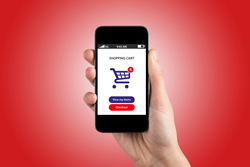By Matt Pufall

How simple is your checkout process for customers? Is it an arduous task for shoppers, or perhaps the opposite, and everything is handled on a single page? This is an important strategy that can’t be overlooked because a complicated checkout process could mean lost business.
In fact, a recent study conducted by UPS found that 20 percent of shoppers left a purchase in their cart because the checkout process was too confusing. Before e-retailers take this statement to heart and strip down the entire e-checkout process for simplicity, consider what’s at stake. The shopping cart checkout process must strike a balance between simplicity and opportunity to increase the average order value (AOV).
What’s Your Path to Purchase?
Before e-retailers can figure out how to maximize the AOV, consider the steps required to make a purchase. Profitable e-retailers make it easy for customers to purchase. Expectations today are high for customers who want to experience a seamless shopping experience. As such, each e-retailer’s mission should be to better understand their customers’ overall preferences and construct a path to purchase that best positions them to service these empowered shoppers.

And while it’s easy to think mobile may offer a more convenient path to purchase, desktop and laptop shoppers remain more focused on the task at hand. A recent Microsoft study shows mobile users are more distracted, which could lead to increased cart abandonment. In addition, the UPS study shows that shopper satisfaction for desktop/laptop is 84 percent, versus just 65 percent for mobile shoppers.
Keep Customers from Wandering Eyes
A customer’s desire to stay in the web store begins with the e-retailer’s range of products, as well as the deals associated with those products. Assortments need to be inspiring. From there, though, smaller e-retailers really have an opportunity to elevate their chances of not only keeping customers in the store and making a purchase, but also increasing the AOV. This can be accomplished since customers searching for products certainly want a good deal, but they’re also shopping for items specific to a certain lifestyle, such as technology enthusiasts. They’re more interested in protecting their investments or willing to invest in additional tech support, for example.
How To Add More Value to the Product
Profitable e-retailers understand they need to provide more than just a good selection of products at a good price. They understand they need to add “value” to their customers’ lives – and purchases. But, this needs to be done in a way that enhances the checkout process, not hinders. Remember, a complicated checkout process will kill away customers, in spite of adding the right value.

Adding value to the purchase can be as simple as bundling complimentary items or services. These can include free shipping on orders of a certain minimum value; special training sessions on products such as computer hardware or technology; memberships to a community of like-minded users; newsletters; and technical support. Loyalty programs are a nice added touch and have been proven to lift revenue for retailers.
Add Trust AND Increase Revenue
An additional way of adding value, as well as increasing AOV, is to help customers build trust and loyalty. A great way to accomplish this is by adding protection plans or warranties for products during the purchase. Customers will appreciate the sense of security knowing their investment will be protected should something go wrong in the future. This sense of security builds trust and loyalty with the e-retailer, and the added value gives the e-retailer a chance to increase AOV and generate more revenue.
It Has to Be Simple
Increasing the AOV is good for the bottom line, but the process needs to be convenient for the shopper. Find the right integration partner who can help enhance each product page or online shopping cart so that adding these product enhancements is automatic or as easy as a single click. Even though they’re technically additional steps, the one-click option makes customers feel like they’re getting something extra without the hassle of a complicated checkout process.
Smaller e-retailers that offer the right products with added value will compete more effectively with larger stores. However, this strategy can only work when the shopping and checkout process is efficient with minimal complications. E-retailers who identify opportunities to make these enhancements to their web store will begin to realize increases to their average order value.
